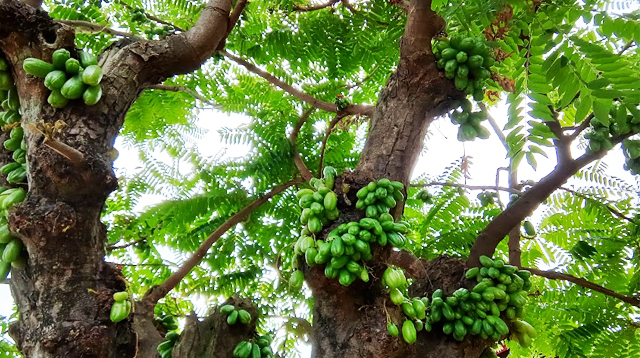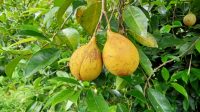SETTING foot on the tropical land of Indonesia, our eyes are often spoiled by the lush greenery of plants. Among the lush leaves, there are unique fruits that not only pamper the tongue, but also store a myriad of benefits. One of them is bilimbi (Averrhoa bilimbi L.), the little bright green one with a refreshing sour taste. Its existence does not only enrich the culinary treasures of the archipelago, but also holds extraordinary herbal medicine potential. Let’s examine the charm of this one fruit in more depth.
Getting to Know More Closely: Physical Characteristics and Habitat of Starfruit
Bilimbi is easily recognized by its distinctive appearance. The tree is medium-sized, reaching a height of 5 to 10 meters. The leaves are compound, small, and arranged tightly along the branches. However, the main attraction lies in the fruit. Oval in shape with a pointed tip, starfruit is about 5-10 cm long and about 2-3 cm in diameter. The skin is thin, light green when young and turns yellowish green when ripe. The surface of the fruit is smooth and juicy.
Another uniqueness of bilimbi is the way it grows. The fruit does not grow at the end of branches like most other fruits, but rather clusters directly on the main trunk and larger branches. This view is often stunning, with tree trunks that seem to be “showered” by hundreds of green fruits.
The original habitat of bilimbi is thought to come from the Southeast Asian region, including Indonesia and Malaysia. However, now this plant has spread widely in various tropical and subtropical countries around the world. In Indonesia itself, starfruit grows well in various regions, both in the lowlands and highlands. People often plant it in their yards as a fruit plant as well as a medicinal plant.
Mouth-watering Taste Sensation: More Than Just Sour
Tasting raw bilimbi gives a strong and refreshing sour taste sensation, sometimes with a touch of bitterness. This sour taste is the main characteristic of this fruit. However, when processed into various dishes, the sour taste of bilimbi actually provides a unique taste dimension and enriches the taste of the dish.
In Indonesian cuisine, starfruit plays a significant role. Its sourness is often used as a substitute for tamarind or vinegar in various traditional dishes. For example, in sour vegetables, starfruit provides a distinctive and different fresh taste. Likewise in dishes such as pindang serani or fish curry, sliced starfruit provides a sour touch that balances the savory and spicy flavors.
In some regions, bilimbi is also processed into various refreshing snacks and drinks. Candied bilimbi, for example, offers a unique combination of sweet and sour flavors. Bilimbi syrup is a refreshing and healthy drink choice, especially during hot weather. In fact, in some communities, pickled starfruit is a delicious and appetizing accompaniment to rice.
Benefits in Daily Life: More than Just a Kitchen Spice
The existence of bilimbi in the daily lives of Indonesian people is not only limited to the culinary realm. In the past, before synthetic soaps and detergents were popular, boiled bilimbi water was often used as a natural cleaning agent. Its acid content is believed to be able to remove stains and grease on clothes and kitchen utensils.
In addition, this fruit which is rich in water is also often used in traditional beauty treatments. People believe that bilimbi masks can help brighten the skin, treat acne, and reduce excess oil. The high vitamin C content in starfruit also acts as an antioxidant that is good for skin health.
Hidden Benefits: Benefits of Bilimbi for Herbal Medicine
Since ancient times, starfruit has been known to have various traditional medicinal properties. Various modern studies have also begun to reveal the pharmacological potential of this one fruit. The content of active compounds such as flavonoids, tannins, saponins, and alkaloids in bilimbi is believed to contribute to various health benefits.
Some of the benefits of starfruit in traditional herbal medicine include:
- Relieves Coughs and Sore Throats: Boiled water from starfruit fruit and leaves is often used as a natural remedy to relieve coughs and sore throats. The content of vitamin C and anti-inflammatory compounds in it is believed to help relieve inflammation and speed healing.
- Overcoming High Blood Pressure: Several early studies have shown that bilimbi extract has the potential to help lower blood pressure. The content of potassium and other active compounds is thought to play a role in this antihypertensive effect.
- Controls Blood Sugar Levels ah: Although further research is needed, several studies have shown that starfruit can help control blood sugar levels in people with diabetes.
- Overcoming Digestive Problems: The fiber content in bilimbi can help smooth digestion and prevent constipation.
- As an Antioxidant: The vitamin C and flavonoid compounds in starfruit act as antioxidants that can protect the body from damage caused by free radicals.
Bilimbi in Various Dishes: An Alluring Sour Touch
In the culinary world, bilimbi is a versatile player that can provide a distinctive sour touch to various types of dishes. Here are some examples of the use of starfruit in cooking:
- Sour Vegetables: The presence of starfruit is a characteristic of several sour vegetable variants, providing a fresh taste that is different from the use of tamarind.
- Pindang Serani: Pindang fish cooked with spices and sliced bilimbi produces a rich and refreshing taste.
- Fish Curry: Bilimbi is often added to fish curry to provide a sour taste that balances the savory taste of coconut milk and the spiciness of spices.
- Bilimbi Sambal: For lovers of spicy and sour, bilimbi sambal is the right choice. The fresh sour taste of bilimbi combined with the spiciness of chili creates a unique sensation.
- Sweets and Syrup: Bilimbi can also be processed into unique sweets with a combination of sweet and sour flavors, as well as refreshing syrup.
- Pickles: Sliced bilimbi is often one of the ingredients in pickles, providing a sour taste that adds freshness to the dish.
Exploring the Taste and Benefits of Bilimbi in Culinary Tourism
For culinary tourists visiting Indonesia, tasting dishes that use bilimbi as one of the ingredients is an unforgettable experience. The unique sour taste sensation will give a new dimension to the taste of traditional cuisine.
When exploring traditional markets or local restaurants, don’t hesitate to look for dishes that use bilimbi. Ask the vendors or stall owners about how they use this little fruit in their dishes. By doing so, you will not only pamper your taste buds, but also gain insight into the richness of Indonesian culinary and herbal medicine traditions.
Bilimbi, the refreshing little sour one, turns out to hold a myriad of charms and benefits. From enriching the taste of dishes to potentially becoming an efficacious herbal medicine, this fruit is proof of Indonesia’s natural wealth that deserves to be preserved and utilized wisely. So, on your culinary journey, don’t miss the opportunity to taste the unique taste and feel the benefits of this extraordinary little sour one. (*)











